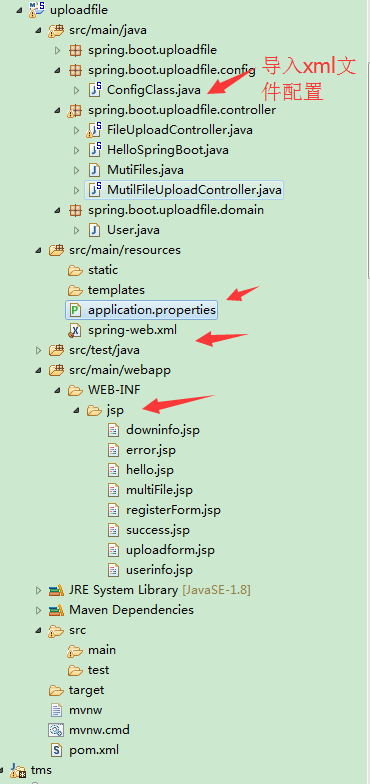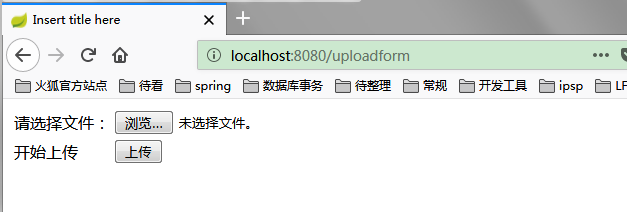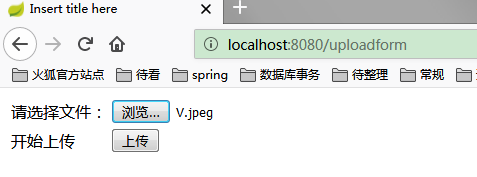背景:之前一直做的是数据库的增删改查工作,对于文件的上传下载比较排斥,今天研究了下具体的实现,发现其实是很简单。此处不仅要实现单文件的上传,还要实现多文件的上传。
单文件的下载知道了,多文件的下载呢??
我这里使用的spring boot来快速搭建spring mvc框架,贼方便,不用都对不起自己。
本篇博客将讲解的是Springmvc的文件上传和下载功能。对于上传功能,我们在项目中是经常会用到的,比如用户注册的时候,上传用户头像,这个时候就会使用到上传的功能。而对于下载,使用场景也很常见,比如我们项目中有个使用说明是是pdf版的,会提供给用户进行下载的功能。相对于来说,这两个功能都是很常见。
搭建Springmvc开发环境
使用spring boot来搭建mvc的框架。
文件目录:

pom.xml文件依赖:
<?xml version="1.0" encoding="UTF-8"?> <project xmlns="http://maven.apache.org/POM/4.0.0" xmlns:xsi="http://www.w3.org/2001/XMLSchema-instance" xsi:schemaLocation="http://maven.apache.org/POM/4.0.0 http://maven.apache.org/xsd/maven-4.0.0.xsd"> <modelVersion>4.0.0</modelVersion> <groupId>spring.boot</groupId> <artifactId>uploadfile</artifactId> <version>0.0.1-SNAPSHOT</version> <packaging>jar</packaging> <name>uploadfile</name> <description>Demo project for Spring Boot</description> <parent> <groupId>org.springframework.boot</groupId> <artifactId>spring-boot-starter-parent</artifactId> <version>2.0.0.RELEASE</version> <relativePath /> <!-- lookup parent from repository --> </parent> <properties> <project.build.sourceEncoding>UTF-8</project.build.sourceEncoding> <project.reporting.outputEncoding>UTF-8</project.reporting.outputEncoding> <java.version>1.8</java.version> </properties> <dependencies> <dependency> <groupId>org.springframework.boot</groupId> <artifactId>spring-boot-starter-web</artifactId> </dependency> <dependency> <groupId>org.springframework.boot</groupId> <artifactId>spring-boot-starter-test</artifactId> <scope>test</scope> </dependency> <!--jsp页面使用jstl标签 --> <dependency> <groupId>javax.servlet</groupId> <artifactId>jstl</artifactId> </dependency> <!--用于编译jsp --> <dependency> <groupId>org.apache.tomcat.embed</groupId> <artifactId>tomcat-embed-jasper</artifactId> <scope>provided</scope> </dependency> <!-- https://mvnrepository.com/artifact/commons-fileupload/commons-fileupload --> <!-- 配置文件上传的bean 控制文件大大小,编码等 --> <dependency> <groupId>commons-fileupload</groupId> <artifactId>commons-fileupload</artifactId> <version>1.3</version> </dependency> <!-- https://mvnrepository.com/artifact/org.apache.commons/commons-io --> <!-- 使用到其中的FileUtil工具类 --> <dependency> <groupId>org.apache.commons</groupId> <artifactId>commons-io</artifactId> <version>1.3.2</version> </dependency> </dependencies> <build> <plugins> <plugin> <groupId>org.springframework.boot</groupId> <artifactId>spring-boot-maven-plugin</artifactId> </plugin> </plugins> </build> </project>
spring-web.xml:
注入这个bean,控制文件的上传。
<?xml version="1.0" encoding="UTF-8"?> <beans xmlns="http://www.springframework.org/schema/beans" xmlns:xsi="http://www.w3.org/2001/XMLSchema-instance" xmlns:p="http://www.springframework.org/schema/p" xmlns:context="http://www.springframework.org/schema/context" xmlns:mvc="http://www.springframework.org/schema/mvc" xmlns:aop="http://www.springframework.org/schema/aop" xsi:schemaLocation="http://www.springframework.org/schema/beans http://www.springframework.org/schema/beans/spring-beans.xsd http://www.springframework.org/schema/context http://www.springframework.org/schema/context/spring-context.xsd http://www.springframework.org/schema/mvc http://www.springframework.org/schema/mvc/spring-mvc.xsd http://www.springframework.org/schema/aop http://www.springframework.org/schema/aop/spring-aop.xsd"> <!-- <mvc:annotation-driven conversion-service="conversionSerivce" /> --> <bean id="multipartResolver" class="org.springframework.web.multipart.commons.CommonsMultipartResolver"> <!-- 默认编码 --> <property name="defaultEncoding" value="utf-8" /> <!-- 文件大小最大值 --> <property name="maxUploadSize" value="80485760" /> <!-- 内存中的最大值 --> <property name="maxInMemorySize" value="40960" /> </bean> </beans>
ps:对于文件大小的控制,在spring boot中出现一个问题,就是xml的配置有时生效,有时不会生效,特别是单文件上传和多文件上传时候会导致上传文件的参数为null。最后的解决办法是通过显示的bean注入的方式。
在使用过程中可以将xml中的bean注释掉,只用下述方式控制即可。
ConfigClass:导入xml文件
package spring.boot.uploadfile.config; import javax.servlet.MultipartConfigElement; import org.springframework.boot.web.servlet.MultipartConfigFactory; import org.springframework.context.annotation.Bean; import org.springframework.context.annotation.Configuration; import org.springframework.context.annotation.ImportResource; /** * ClassName:ConfigClass <br/> * Function: TODO <br/> * Date: 2018年3月2日 下午8:20:05 <br/> * @author prd-lxw * @version 1.0 * @since JDK 1.7 * @see */ /** * classpath路径:locations={"classpath:application-bean1.xml","classpath:application-bean2.xml"} * file路径: locations = {"file:d:/test/application-bean1.xml"}; */ @Configuration @ImportResource(locations = { "classpath:spring-web.xml" }) //@ImportResource(locations={"file:d:/test/application-bean1.xml"}) public class ConfigClass { @Bean public MultipartConfigElement multipartConfigElement() { MultipartConfigFactory factory = new MultipartConfigFactory(); //文件最大 factory.setMaxFileSize("1000240KB"); //KB,MB /// 设置总上传数据总大小 factory.setMaxRequestSize("102400KB"); return factory.createMultipartConfig(); } }
以上配置是spring boot中的内容,此处简单讲解,主要就是mvc框架的搭建。
实现文件上传的功能
2.1:首先我们来新建一个jsp页面,命名为:uploadform.jsp:
<%@ page language="java" contentType="text/html; charset=UTF-8" pageEncoding="UTF-8"%> <!DOCTYPE html PUBLIC "-//W3C//DTD HTML 4.01 Transitional//EN" "http://www.w3.org/TR/html4/loose.dtd"> <html> <head> <meta http-equiv="Content-Type" content="text/html; charset=UTF-8"> <title>Insert title here</title> </head> <body> <form action="gotoAction" enctype="multipart/form-data" method="post"> <table> <tr> <td>请选择文件:</td> <td><input type="file" name="file"></td> </tr> <tr> <td>开始上传</td> <td><input type="submit" value="上传"></td> </tr> </table> </form> </body> </html>
ps:上传页面jsp的编写
写一个上传的页面form表单,其中一定要注意的是在表单的属性中添加entcypt="multipart/form-data",这表示上传的将会是二进制流的格式,以规定的二进制进行上传,便于服务器处理,使用post请求:
2.2:再写一个上传成功的jsp页面,主要是用来当上传成功时候跳转的页面,命名为:success.jsp
<body> <h2>文件上传成功!</h2> </body>
2.3:然后再写一个上传失败的页面,主要是用来当上传失败的时候跳转的页面,命名为:error.jsp
<body> <h2>文件上传失败!请检查文件是否存在</h2> </body>
2.4:写好了jsp页面,接下来就是写我们的控制器了,Springmvc控制器,我们写了一个FileUploadController类,然后写上具体的代码,如下所示,
注意其中使用MultipartFile来接受form表单传过来的file文件,MultipartFile有几个核心的api,可以供我们使用,比如 boolean isEmpty(),用来判断文件是否为空。void transferTo( File file),把文件写入目标路径地址
下属代码是最终实验的Controller中的代码。后面的详解因为太累了,直接复制原来的文章。。。。。

/** * Project Name:uploadfile * File Name:FileUploadController.java * Package Name:spring.boot.uploadfile.controller * Date:2018年3月2日下午8:28:42 * Copyright (c) 2018, 深圳金融电子结算中心 All Rights Reserved. * */ package spring.boot.uploadfile.controller; import java.io.File; import java.io.IOException; import java.util.Map; import javax.servlet.http.HttpServletRequest; import org.apache.commons.io.FileUtils; import org.springframework.http.HttpHeaders; import org.springframework.http.HttpStatus; import org.springframework.http.MediaType; import org.springframework.http.ResponseEntity; import org.springframework.stereotype.Controller; import org.springframework.ui.Model; import org.springframework.web.bind.annotation.ModelAttribute; import org.springframework.web.bind.annotation.PathVariable; import org.springframework.web.bind.annotation.RequestMapping; import org.springframework.web.bind.annotation.RequestMethod; import org.springframework.web.bind.annotation.RequestParam; import org.springframework.web.multipart.MultipartFile; import spring.boot.uploadfile.domain.User; /** * ClassName:FileUploadController <br/> * Function: 实现spring中的单文件上传与下载,文件可以作为一个参数传递,也可以作为bean的一个属性传递 * Date: 2018年3月2日 下午8:28:42 <br/> * @author prd-lxw * @version 1.0 * @since JDK 1.7 * @see */ @Controller public class FileUploadController { /** * 首次进入时候的页面 * @param formName * @return */ @RequestMapping(value = "/{formName}") public String loginForm(@PathVariable String formName) { return formName; } /** * 实现单文件的上传 * @param file * @param request * @return */ @RequestMapping(value = "/gotoAction", method = RequestMethod.POST) public String upload(@RequestParam("file") MultipartFile file, HttpServletRequest request) { if (!file.isEmpty()) { String contextPath = request.getContextPath();//"/SpringMvcFileUpload" String servletPath = request.getServletPath();//"/gotoAction" String scheme = request.getScheme();//"http" String storePath = "E:\testJava\filesss";//存放我们上传的文件路径 String fileName = file.getOriginalFilename(); File filepath = new File(storePath, fileName); if (!filepath.getParentFile().exists()) { filepath.getParentFile().mkdirs();//如果目录不存在,创建目录 } try { file.transferTo(new File(storePath + File.separator + fileName));//把文件写入目标文件地址 } catch (Exception e) { e.printStackTrace(); return "error"; } return "success";//返回到成功页面 } else { return "error";//返回到失败的页面 } } /** * 将文件作为bean的一个属性上传 * @param user * @param request * @param map * @return */ @RequestMapping(value = "/register", method = RequestMethod.POST) public String reg(@ModelAttribute User user, HttpServletRequest request, Map<String, Object> map) { final String wrong = "error"; final String good = "success"; MultipartFile headimage = user.getHeadimage(); boolean empty = headimage.isEmpty(); if (!empty) { String realPath = request.getServletContext().getRealPath("/images"); String uploadPath = "E:\testJava\filesss"; String headimageName = headimage.getOriginalFilename(); File imageFile = new File(uploadPath, headimageName); try { headimage.transferTo(new File(uploadPath + File.separator + headimageName)); } catch (Exception e) { e.printStackTrace(); return wrong; } map.put("user", user); return "userinfo"; } else { return wrong; } } /** * 实现单文件的下载 * @param request * @param filename * @param model * @return * @throws IOException */ @RequestMapping(value = "/download", method = RequestMethod.GET) //匹配的是href中的download请求 public ResponseEntity<byte[]> download(HttpServletRequest request, @RequestParam("filename") String filename, Model model) throws IOException { String downloadFilePath = "E:\testJava\filesss";//从我们的上传文件夹中去取 File file = new File(downloadFilePath + File.separator + filename);//新建一个文件 // byte[] body = null; // InputStream is = new FileInputStream(file); // body = new byte[is.available()]; // is.read(body); HttpHeaders headers = new HttpHeaders();//http头信息 String downloadFileName = new String(filename.getBytes("UTF-8"), "iso-8859-1");//设置编码 headers.setContentDispositionFormData("attachment", downloadFileName); headers.setContentType(MediaType.APPLICATION_OCTET_STREAM); //MediaType:互联网媒介类型 contentType:具体请求中的媒体类型信息 return new ResponseEntity<byte[]>(FileUtils.readFileToByteArray(file), headers, HttpStatus.CREATED); } }
User.java
/** * Project Name:uploadfile * File Name:User.java * Package Name:spring.boot.uploadfile.domain * Date:2018年3月2日下午8:41:47 * Copyright (c) 2018, 深圳金融电子结算中心 All Rights Reserved. * */ package spring.boot.uploadfile.domain; import java.io.Serializable; import org.springframework.web.multipart.MultipartFile; /** * ClassName:User <br/> * Function: 将文件作为bean的一个属性 * Date: 2018年3月2日 下午8:41:47 <br/> * @author prd-lxw * @version 1.0 * @since JDK 1.7 * @see */ public class User implements Serializable {//用户实体类 /** */ private static final long serialVersionUID = 1L; private String userName; private MultipartFile headimage; //上传文件会自动绑定到该属性 //省略getter和setter方法 }
2.5:好了,到此我们就可以实现上传功能了,发布在Tomact容器里,然后就可以进行上传文件了。
在浏览中输入:http://localhost:8080/uploadform
具体的页面请求如下,然后浏览具体的文件,点击上传按钮:

点击浏览,上传

然后执行相应的方法,完成文件的上传。
三:将上传文件绑定到具体的对象上
3.1:首先我们来定义一个实体类User,这个实体类中的headimage属性的主要作用就是用来映射我们上传的文件,可以看到它是MultipartFile类型的:
三:将上传文件绑定到具体的对象上
3.1:首先我们来定义一个实体类User,这个实体类中的headimage属性的主要作用就是用来映射我们上传的文件,可以看到它是MultipartFile类型的:

将上传文件绑定到具体的对象上
3.1:首先我们来定义一个实体类User,这个实体类中的headimage属性的主要作用就是用来映射我们上传的文件,可以看到它是MultipartFile类型的:
public class User implements Serializable{//用户实体类 private String userName; private MultipartFile headimage;//上传文件会自动绑定到该属性 //省略getter和setter方法 }
3.2:然后写我们的 jsp上传页面,这里我们来模拟一个用户注册上传头像的场景,新建一个registerForm.jsp页面,然后写一个form表单,如下:
<body>
<h2>用户注册</h2>
<form action="register" enctype="multipart/form-data" method="post">
<table>
<tr>
<td>用户头像:</td>
<td><input type="file" name="headimage"></td>
</tr>
<tr>
<td>上传:</td>
<td><input type="submit" value="上传"></td>
</tr>
</table>
</form>
</body>
3.3:写我们的方法控制器处理注册逻辑的层的代码,注意其中的user对象加入了@ModelAttribute注解,其主要作用是用来映射把上面的form表单的headimage属性自动注入到对象里面,还有Map<String,Object> map主要是为了存放user对象,放在requestScope里面,这样就可用el表达式把其中的值取出来了。
@RequestMapping(value="/register",method=RequestMethod.POST) public String reg(@ModelAttribute User user,HttpServletRequest request,Map<String,Object> map){ final String wrong="error"; final String good="success"; MultipartFile headimage = user.getHeadimage(); boolean empty = headimage.isEmpty(); if (!empty) { String realPath = request.getServletContext().getRealPath("/images"); String uploadPath="D:\userUploadFile\Files"; String headimageName = headimage.getOriginalFilename(); File imageFile = new File(uploadPath,headimageName); try { headimage.transferTo(new File(uploadPath+File.separator+headimageName)); } catch (Exception e) { e.printStackTrace(); return wrong; } map.put("user", user); return "userInfo"; }else { return wrong; } }
3.4:我们来新建一个jsp页面,取名为userinfo.jsp,其主要作用是显示刚才的我们的文件名:
<body>
用户头像:${requestScope.user.headimage.originalFilename}
</body>
3.5:页面写完了,我们在来模拟测试一下,在客户端Ie浏览器中,输入http://localhost:8080/SpringMvcFileUpload/registerForm:


实现用户下载的功能
4.1:首先定义一个downinfo.jsp
<%@ page language="java" contentType="text/html; charset=UTF-8" pageEncoding="UTF-8"%> <!DOCTYPE html PUBLIC "-//W3C//DTD HTML 4.01 Transitional//EN" "http://www.w3.org/TR/html4/loose.dtd"> <html> <head> <meta http-equiv="Content-Type" content="text/html; charset=UTF-8"> <title>Insert title here</title> </head> <body> <h3>文件下载</h3> <a href="download?filename=V.jpeg"> 用户头像:V </a> </body> </html>
4.2:来看看我们的download控制器代码:注意download方法返回的是ResponseEntity<byte[]> 类型,这个是封装好的返回类型,我们需要传入byte数组、headers、HttpStatus,然后它就会返回具体的下载流,调用客户端去下载资源
@RequestMapping(value="/download",method=RequestMethod.GET) //匹配的是href中的download请求 public ResponseEntity<byte[]> download(HttpServletRequest request,@RequestParam("filename") String filename, Model model) throws IOException{ String downloadFilePath="D:\userUploadFile\Files";//从我们的上传文件夹中去取 File file = new File(downloadFilePath+File.separator+filename);//新建一个文件 HttpHeaders headers = new HttpHeaders();//http头信息 String downloadFileName = new String(filename.getBytes("UTF-8"),"iso-8859-1");//设置编码 headers.setContentDispositionFormData("attachment", downloadFileName); headers.setContentType(MediaType.APPLICATION_OCTET_STREAM); //MediaType:互联网媒介类型 contentType:具体请求中的媒体类型信息 return new ResponseEntity<byte[]>(FileUtils.readFileToByteArray(file),headers,HttpStatus.CREATED); }
ps:此处注意这两个类的jar包。
FileUtils来自org.apache.commons.commons-io

4.3:我们来测试一下写的东西是否能准确运行,点击超链接,注意此链接指向的地址:http://localhost:8080/SpringMvcFileUpload/download?filename="myheadimage".jpg,这就表示这个链接会去请求控制器,然后控制器进行处理下载, 这样就完成了文件的下载功能了:

点击超链接:

总结
本篇博文介绍了SpringMvc上传和文件的功能,需要注意的地方就是对于文件上传包common-fileupload.jar包的使用,还有在配置文件上配置mulitipartResolver这个bean。下面又介绍了用java 实体类去映射上传文件的属性对应的文件,这点的好处就是它会自动映射,然后把对象放入到我们的请求域中,就可以展示给界面用户层,这也是mvc思想模式的体现。接下来是介绍去下载文件,只需要从我们的写入的目标地址去取出文件,再进行responseEntity对象的封装,就可以实现下载功能
